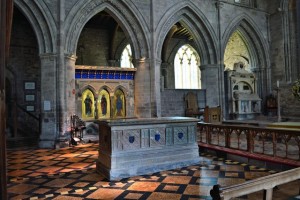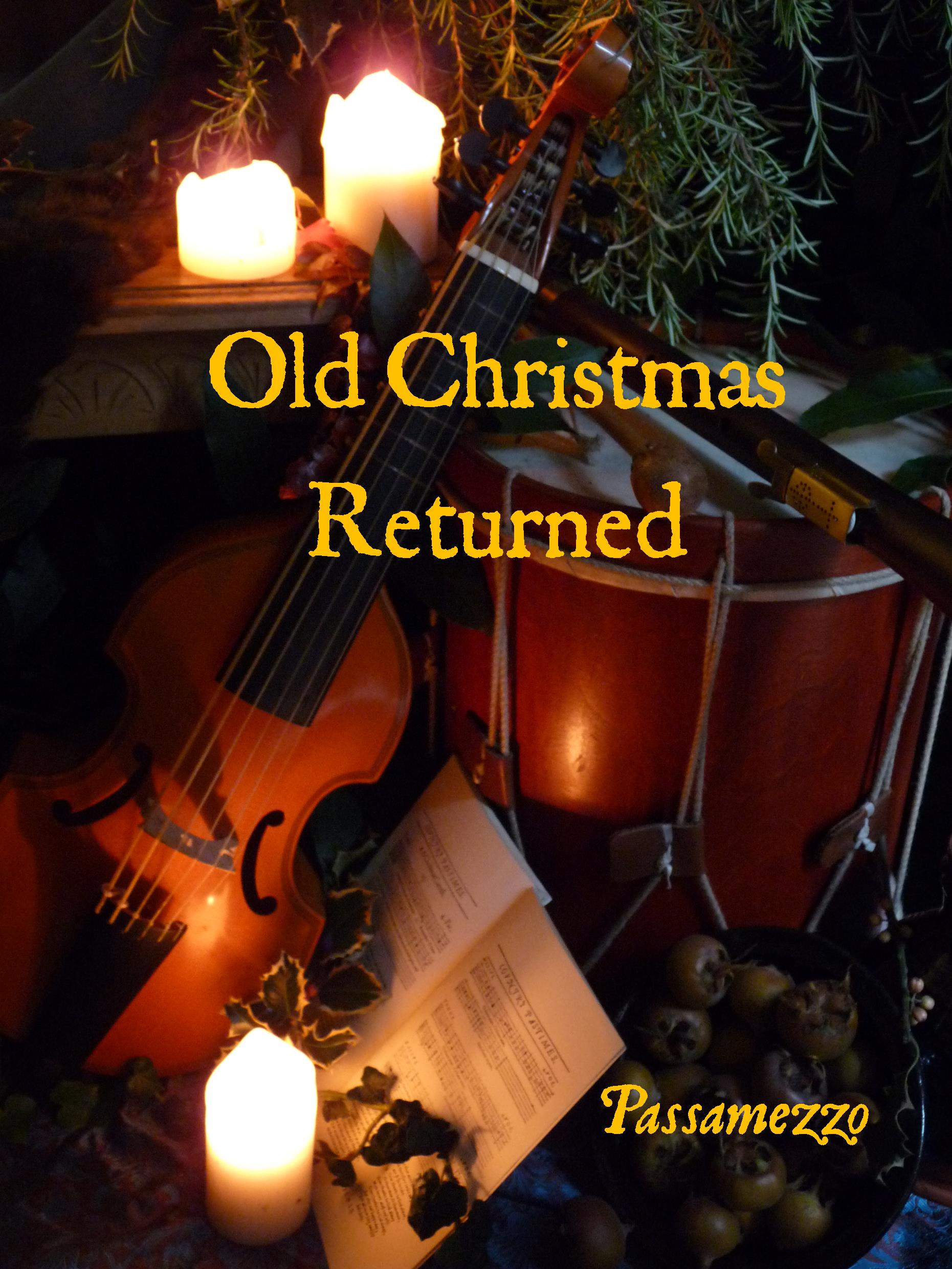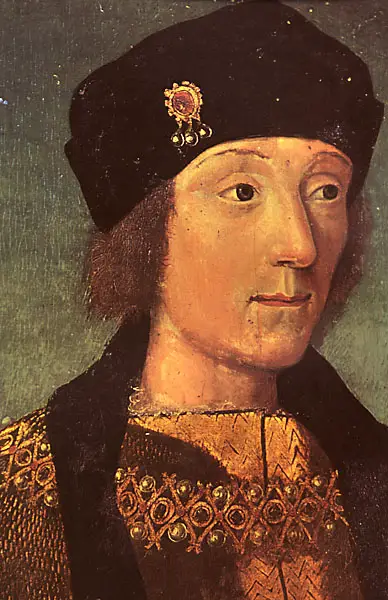 Today marks the anniversary of the death of Edmund Tudor, 1st Earl of Richmond, on 1st November 1456. He died from the plague at Carmarthen Castle.
Today marks the anniversary of the death of Edmund Tudor, 1st Earl of Richmond, on 1st November 1456. He died from the plague at Carmarthen Castle.
Thank you to Sarah Bryson for writing this article on Edmund for us.
Henry Tudor, King Henry VII, was the founder of the Tudor Dynasty. His mother was the imposing Margaret Beaufort who risked everything to see her son on the throne and in turn the houses of Lancaster and York united through the marriage of her son to Elizabeth of York, daughter of Edward IV. But who was Henry Tudor's father? While so much is known about Henry's mother, his father is a much more elusive figure and sadly he did not live to see his only son and heir claim the English throne.
Edmund Tudor was the son of Owen Tudor and the Dowager Queen Katherine Valois. Young and beautiful Katherine Valois was the French consort of the great King Henry V and the mother of Henry VI. She was just twenty years of age when her husband Henry V died on the 31st August 1422 at the Chateau de Vincennes, near Paris, while in Europe campaigning. It was reported that Edmund Beaufort, Duke of Somerset, sought to marry the Dowager Queen and it may very well have been that Katherine returned these feelings. In response, Parliament set out a statue which stated that no man was allowed to marry a former queen of England without a special licence and permission from the King. If a man dared to marry a former queen then not only would he forfeit his lands and tenements, he would also forfeit his life.
The Duke of Somerset paid attention to this statue and reined back his intentions. However, Owen Tudor was a completely different story. Reported to be a squire in the service of the dowager queen, Owen Tudor soon caught the queen's attention. There are various stories as to how this happened, one being that while dancing Owen fell into the queen's lap, another being that she spied him while he was swimming naked – whatever the true story is, the pair married in secret, going against the statute of parliament.
The pair had several children together, the two most famous of those being Edmund Tudor and his younger brother Jasper. Edmund Tudor was born around 1430 at Hadham, Hertfordshire. It has been suggested that Edmund was the son of Edmund Beaufort, Duke of Somerset, as there are no Edmunds in either Owen Tudor or Katherine Valois' families. However, this is unlikely and it may simply be that he was named after the duke in his honour or that both Owen and Katherine liked the name. Katherine would have several more children before retiring to the Abbey of Bermondsey in 1436 where she died less than a year later on 3rd January 1437.
At just six or seven years of age, Edmund and his younger brother Jasper went to live with Catherine de la Pole, Abbess of Barking. Unfortunately there are very few details of Edmund's early years, but it is known that both Owen and Jasper were raised with Catherine de la Pole until around 1442, when they were taken to court to meet their older half-brother, King Henry VI. After this time, the King took charge of Edmund and Jasper's education and Edmund remained at court.
To strengthen the position of the King's half-brothers, on 23rd November 1452 Henry VI had Parliament begin the process to declare both Edmund and Jasper legitimate. The King then created Edmund Earl of Richmond while his younger brother Jasper was created the Earl of Pembroke. They were to take precedence above all the noblemen below the rank of a duke. Then on 5th January 1453, at the Tower of London, both Edmund and Jasper were knighted. Finally, on the 6th March 1453, the Commons petitioned the king to declare Edmund and Jasper as his legitimate brothers, due to them sharing the same mother, and the king graciously accepted. In 1454, The king made several large grants to Edmund to strengthen his land base and wealth, and in addition to this, on 24th March, Edmund and Jasper were jointly granted the wardship of nine year-old Lady Margaret Beaufort. Margaret Beaufort, daughter of John Beaufort, 1st Duke of Somerset, was the sole heiress to her father's great fortune. She had originally been betrothed to John de la Pole, son of William de la Pole, Duke of Suffolk, but the king annulled the marriage and sought a marriage for the young heiress elsewhere. To secure Margaret's wealth, Edmund married her on 1st November 1455. He was twenty four/five years of age and she was just twelve.Although the accepted age for marriage during the Tudor period was around twelve years of age for girls and fourteen years of age for boys, most believed that twelve was far too young for a girl to be participating in sexual intercourse. Thus, many young married couples were ordered to wait to have sex until the girl was around fourteen to sixteen years of age. However, Edmund decided not to wait until his new wife was fourteen and wished to consummate the marriage as soon as possible to secure its legitimacy. Shortly afterwards, Margaret became pregnant. She gave birth before she was even thirteen years old. It is believed that due to her young age and slender frame the birth had a dramatic and lasting effect upon her body and despite marrying twice more she never conceived another child.
Edmund did not live to see the birth of his son, the future Henry VII. During this time, the famous Wars of the Roses had begun. There were periods of time when King Henry VI was not able to rule effectively, due to what was suspected to be some form of mental illness. During this time, the Duke of York took control of the kingdom and ruled as Protector of the Realm. When Henry VI returned to full sanity, his wife, Margaret of Anjou, and Edmund Beaufort, Duke of Somerset, took control once more. Soon war was declared between the houses of York and Lancaster and while the Wars of the Roses are far too great to detail here it was in one of these battles that Edmund was involved and which led to his end.
Edmund, a Lancastrian and fighting for his king and half-brother, was captured in 1456 by William Herbert, a Yorkist supporter. Edmund was taken to Carmarthen Castle in Wales, where he was held captive. It was there on 1st November 1456 that he died of the plague, just two months before his only son and heir was born. There were rumours at the time that Edmund had been poisoned or perhaps succumbed to injuries sustained during fighting, but nowadays it is generally accepted that he died of the plague. Edmund was buried at the monastery of Grey Friars in Carmarthen. However in 1539, more than eighty years after his death, at the dissolution of the monasteries, Edmund's grandson Henry VIII had his grandfather's remains moved to the to the choir of St David's Cathedral, where they remain today. At the time of his death, Edmund's lands were valued at around £600 a year and they reverted back to the crown. However, Edmund's young wife Margaret received a dower of £200 a year.
Edmund's younger brother Jasper took care of his young sister-in-law, taking her in to stay with him at Pembroke Castle. It was there, on 28th January 1457, that Edmund's son and heir, Henry VII, was born.
Sarah Bryson is the author of Mary Boleyn: In a Nutshell. She is a researcher, writer and educator who has a Bachelor of Early Childhood Education with Honours and currently works with children with disabilities. Sarah is passionate about Tudor history and has a deep interest in Mary Boleyn, Anne Boleyn, the reign of Henry VIII and the people of his court. Visiting England in 2009 furthered her passion and when she returned home she started a website, queentohistory.com, and Facebook page about Tudor history. Sarah lives in Australia, enjoys reading, writing, Tudor costume enactment and wishes to return to England one day. She is currently working on a biography of Charles Brandon, Duke of Suffolk.
Sources
Image: The shrine of St David and the tomb of Edmund Tudor, © Copyright Philip Pankhurst and licensed for reuse under this Creative Commons Licence.
- Bayani, Debra (2014), Jasper Tudor: Godfather of the Tudor Dynasty.
- Gregory, Philippa (2015) Edmund Tudor, Philippa Gregory, viewed 17 October 2015, http://www.philippagregory.com/family-tree/edmund-tudor.
- Higginbothom, Susan (2013) Arms and the Man: Was Edmund Tudor Illegitimate?, History Refreshed, viewed 17 October 2015, http://www.susanhigginbotham.com/blog/posts/arms-and-the-man-was-edmund-tudor-illegitimate/.
- Medieval Lives: Birth, Marriage and Death 2013, BBC Scotland.
- Ridgway, Claire (2012) On This Day in Tudor History, MadeGlobal Publishing.




Really enjoyed reading this article and enjoying finding out more about the tudor background. Thank you.
Great article highlighting a key and really interesting part of the Tudor history that is often overlooked!
No doubt you have heard the mad story about what happened after Owen’s death in Hereford Market square.
Just before Owen laid his head on the block he was said to have remarked “This head used to lie in the lap of a Queen of England”
After his head was severed it was put on the town hall steps, a woman is supposed to have screamed at the sight of it, and picked it up and sat with it in her lap talking to it, stroking and combing it’s blood soaked hair. The woman refused to let anyone come near her, and eventually had to be dragged kicking and screaming away from poor Owen’s head. No one knows who the lady was, but many believed it was actually Catherine. Of course we all know that’s impossible because she was long dead when he was executed. The other possibility is a lady called Margaret, who was believed to be Owen’s lover after Catherine had died.
I’ve also heard that story! I’ve heard that it was the mother of Owen’s illegitimate son David. Seems as to who ever it was there must be some truth as the story is well known….
Great article, thanks! I have often wondered about Edmund. All I knew of him before were cryptic mentions. I wondered why Henry VI raised him to such honors, considering offspring of his mother would not inherit English titles/lands.
A couple of errors to correct: in paragraph 5, “statue” should be “statute”.
In paragraph 7, you say, “both Owen and Jasper were raised with” where you don’t mean Owen, you mean Edmund.